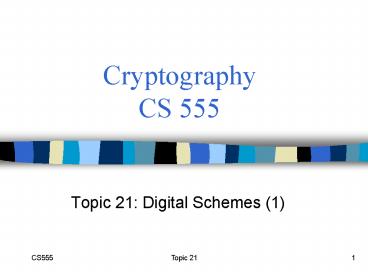Cryptography CS 555 PowerPoint PPT Presentation
Title: Cryptography CS 555
1
CryptographyCS 555
- Topic 21 Digital Schemes (1)
2
Outline and Readings
- Outline
- Digital signature
- RSA signatures
- Hash and sign
- Readings
- Katz and Lindell Chapter 12.1-12.4
3
Digital Signatures The Problem
- Consider the real-life example where a person
pays by credit card and signs a bill the seller
verifies that the signature on the bill is the
same with the signature on the card - Contracts are valid if they are signed.
- Signatures provide non-repudiation.
- ensuring that a party in a dispute cannot
repudiate, or refute the validity of a statement
or contract. - Can we have a similar service in the electronic
world? - Does Message Authentication Code provide
non-repudiation? Why?
4
Digital Signatures
- MAC One party generates MAC, one party verifies
integrity. - Digital signatures One party generates
signature, many parties can verify. - Digital Signature a data string which associates
a message with some originating entity. - Digital Signature Scheme
- a signing algorithm takes a message and a
(private) signing key, outputs a signature - a verification algorithm takes a (public)
verification key, a message, and a signature - Provides
- Authentication, Data integrity, Non-Repudiation
5
Digital Signature
- A signature scheme consists of the following
three PPT algorithms - (pk,sk) ? Gen(1n) key generation
- ?? ? Signsk(m) signing
- b Vrfypk(m,t) verification algorithm b1
meaning valid, b0 meaning invalid - Must satisfy ? (pk,sk) ?m Vrfypk(m, Signsk(m))
1 - Assume that receiver has an authentic copy of the
senders public key, then receiver can verify
that a document is indeed sent by the sender.
6
Security of Signature Schemes
- The experiment Sig-forgeA,?
- (pk,sk) ?Gen(1n)
- Adversary A is given pk and oracle access to
Signsk(?) - Adversary outputs (m, ?). Let Q denote the set
of all queries that A asked to the oracle. - Adversary wins if Vrfypk(m, t) 1 and m ? Q
- A signature ? is existential unforgeable under an
adaptive chosen-message attack (or just secure)
if for all PPT A, there exists a negligible
function negl such that PrMac-forgeA,?1 ?
negl(n)
7
Textbook RSA Signatures
- Key generation (as in RSA encryption)
- Public key (e, n) used for verification
- Private key d, used for generation
- Signing message m with private key
- Compute ? md mod n
- Verifying signature ? using public key (e, n)
- Check whether ?e mod n m
8
Insecurity of Textbook RSA
- A no-message attack
- Choose arbitrary ?, compute m ?e mod n
- (m,?) is a valid pair
- One cannot control what is m
- Forging signature on arbitrary message
- To forge signature on message m, query signing
oracle for m1 (obtaining ?1) and m2m/m1 (mod n)
(obtaining ?2) - (m, ?1 ?2) is a valid pair
9
RSA Signatures with Hash
- Use a hash function H 0,1? Zn
- Signing message m with private key (n,d)
- Compute ? H(m)d mod n
- Verifying signature ? using public key (e, n)
- Check whether ?e mod n H(m)
- Can be proven secure assuming that H is random
oracle. (This is not considered a valid proof of
security, but means that no known attack exists.)
10
Hash and Sign Paradigm
- Enabling the signing of arbitrary long message.
- Given a secure signing scheme (for a fixed
message space), and a collision-resistant hash
function, first hash and then sign is also
secure. - Textbook RSA is insecure, so this result does
not apply to hash and sign with RSA - Any attack either finds a collision or breaks the
security of the signing scheme.
11
Non-repudiation
- Nonrepudiation is the assurance that someone
cannot deny something. Typically, nonrepudiation
refers to the ability to ensure that a party to a
contract or a communication cannot deny the
authenticity of their signature on a document or
the sending of a message that they originated. - Can one deny a signature one has made?
- Does email provide non-repudiation?
12
Coming Attractions
- Other Signature Schemes
- Reading Katz Lindell Chapter 12.5,12.7

